Meet the group course manager: Chris Brook
Related Articles
Chris, from The Club Company, which operates 15 country clubs, is one of the UK’s most senior greenkeepers. He discusses what his role entails, how the pandemic has affected this, how he deals with leatherjackets, some of the projects that are taking place at the venues and how they carry out topdressing work.
Chris Brook joined The Club Company more than 30 years ago and today is the group course manager. He’s a very modest man, who has been in the industry for almost 40 years and shuns the limelight. However, we managed to persuade him to ‘open up’ about his career and it’s the perfect example for young, aspiring greenkeepers.
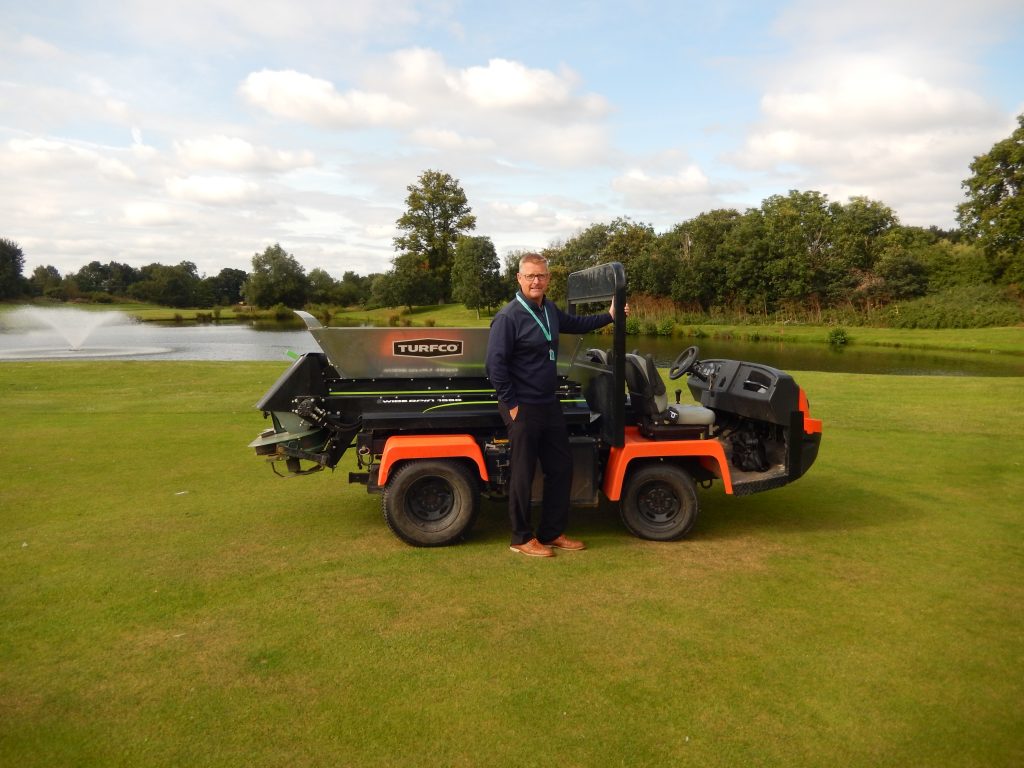
What was your path to group course manager, how did you learn, where did you study and how long have you now been working for The Club Company?
After studying for my A-Levels in the early 1980s, I took a seasonal job at my local club, Knebworth, where I was given a strimmer, some basic instruction and I was away. I loved it from the very first day and not long after, when one of the team left, I was offered a full-time role. My parents weren’t too happy, but I knew it was the life for me.
Knebworth were very encouraging and I studied at Oaklands College where I gained my City & Guilds certification at various levels and also received plenty of on-the-job training from very supportive colleagues.
In 1985 I was offered the position of deputy course manager at Brookmans Park, where I spent two happy years, before being enticed back to Knebworth in the same role, but with the prospect of becoming the course manager.
It was at Knebworth where I made a career defining decision: the position of course manager came at the same time I was offered the chance to get involved in a new course build at Chesfield Downs. After numerous sleepless nights and lots of discussions with my wife, we decided that the Chesfield Downs project was too good an opportunity to turn down, so off I went.
It was Jonathan Gaunt’s first golf course design project and he doubled up as construction manager. At the time it was one of the longest courses in the UK at 6,646 yards and built on rolling chalk downland. I worked very closely with him throughout and it was a very steep, and sometimes fraught, learning curve, but it taught me so much, especially about the grow-in process, which has served me well in my career. We began construction in 1989 and opened in 1991 with one of the early members being a young Ian Poulter.
In 1999 the club was sold from private ownership to The Club Company and shortly afterwards they added Mentmore Golf & Country Club to their growing portfolio. I was seconded to Mentmore to help integrate it into the group and remained there until it was sold in 2008 when I moved to Castle Royle as course manager.
From 1997 until 2008, in conjunction with Alan Collis, we jointly managed the clubs within the group. When Alan retired in 2008, I was promoted to my current role.
Can you describe your current job function, what you are responsible for exactly and who do you report to?
This should be easy to answer, but it’s not that simple. The easy part is that I report to Mark Warne, our property facilities director. I believe we are the longest serving employees of The Club Company, so we’ve known each other for years. We get on really well, but our friendship doesn’t get in the way; I have to justify all my cap-ex by making a sound business case and that’s how it should be.
As you might expect, my responsibilities are many and varied. My main role is to ensure that all the golf courses, driving ranges and practice facilities across the group are in the best possible condition for our members. I’m a mentor for individual course managers and visit each site regularly, walk the course and offer advice. I’m the conduit back to the senior management team on staffing matters and equipment upgrades and a lot of the time I’m problem solving; just like any other manager looking after a large team. I suppose, if the courses have an issue, the buck stops with me.

How frequently do you visit each of the courses and what generally is the purpose of the visit; what do you look to achieve?
I try to work a rota system, but that isn’t set in stone and I have to be flexible if something that needs my attention crops up. I live in Hertfordshire, so sometimes I can visit two clubs in one day, for example The Essex and Benton Hall are about 10 miles from each other, or when I visit The Tytherington in Cheshire, it might require an overnight stay.
As I said earlier, my visits usually involve a course walk where I’ll discuss future improvements and look at the progress of any renovation work; I’ll monitor staff morale, ensure that our H&S procedures are in place and being followed and discuss staffing matters: for example, we’re looking to add staff at Nizels, so we’re discussing the number and calibre of the people required.
What effect did the pandemic have on the working patterns of the greenkeeping staff and to The Club Company, and have you seen a significant uplift in new members and players to the courses?
Like many clubs we’ve definitely benefited from an uplift in the membership. Members have preference on tee times and throughout the summer months we have 6am starts on both the first and the ninth. I think the furlough scheme played its part in greater participation but, with people returning to work, that has now levelled off.
The fitness side of the business has suffered as gym visits were one of the last sanctions to be removed, but we did erect marquees in the car parks to allow fitness classes to continue, socially distanced and in many cases with the sides of the tents removed.
The early starts do put a lot of pressure on the greenkeeping teams as you would expect. We have to get ahead of the golfers at two locations and when you take into account staff absenteeism due to Covid that adds to the pressure. At Castle Royle, our course manager Laurence McCrory went down with it, so I took a more hands-on role in his absence.
During the lockdowns we had skeleton teams in to keep the courses in shape, while others were furloughed. I must admit, from a greenkeeper’s perspective, the lack of golfers gave the turf a much-needed rest during what was a very cold and wet few months, so that was a bonus. It also allowed us to complete some bunker renovations, without affecting the members. The management were excellent; we were able to plan a return to work, so everybody was back in a month prior to coming out of lockdown.
We’ve been through 18 months of the pandemic. What experiences would you say that you have taken from this pandemic whilst working and what lessons have you learned?
I can sum that up in one word: flexibility. We’ve had to react to each situation as it arose and find a solution. For those who were furloughed we had to maintain their morale; for those who stayed working we had to ensure their safety, so we split them into two teams, with no mixing, different lunch breaks and enhanced cleaning regimes. I think what I’ve learned is to take nothing for granted, be adaptable and really look after your people.
Tee time bookings currently start at 06.00am and are running until dusk, seven days a week. How are the teams currently working to maintain the courses to a high standard, when faced with a sea of continual golfers?
All of my teams are working incredibly hard! They are in by about 5:15am, just to get out and keep ahead of the golfers. It’s even more stressful with a two-tee start, but they do it. All we ask is for a little bit of consideration from the members, if we happen to be mowing a green as they approach the hole.
We have to remember at all times that it’s the membership that pay our wages, but generally it’s gone well.
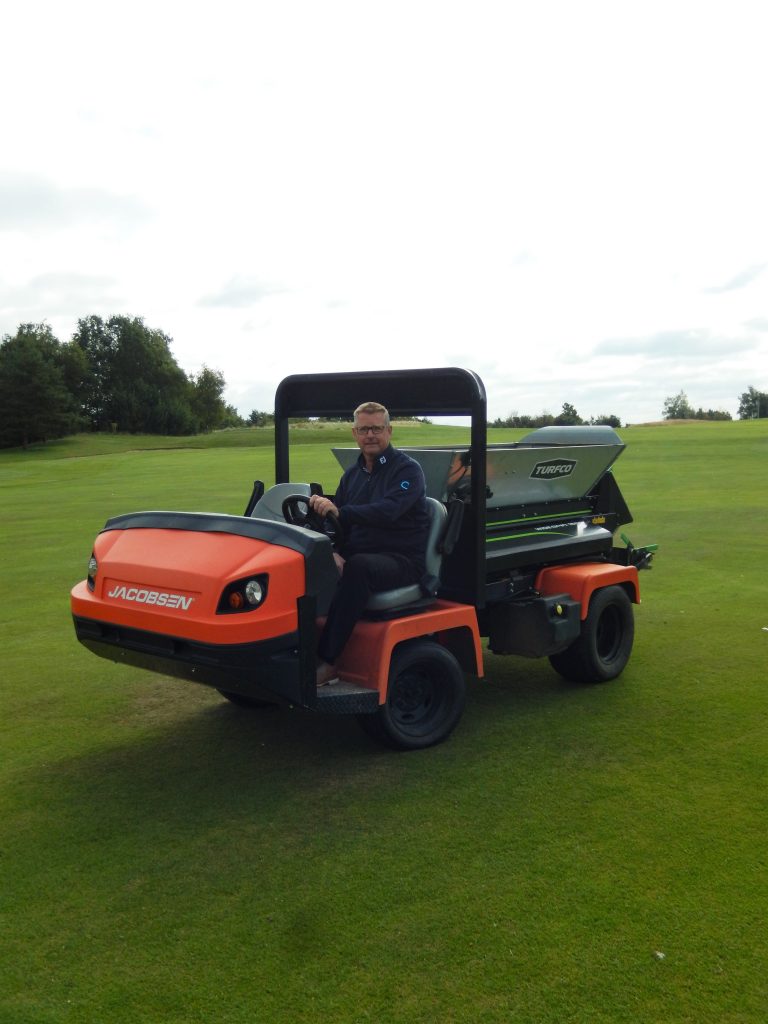
The Club Company always seems to be investing. How many clubs are currently in the group?
We currently have 15 clubs within the group and they are:
- Benton Hall, Witham, Essex
- Castle Royle, Knowl Hill, Berkshire
- Cams Hall Estate, Fareham, Hampshire
- Chartham Park, East Grinstead, West Sussex
- Chesfield Downs, Graveley, Hertfordshire
- The Club at Mapledurham, Reading, Berkshire
- The Club at Meyrick Park, Bournemouth, Dorset
- The Essex, Earls Colne, Essex
- Lichfield Golf & Country Club, Lichfield, Staffordshire
- Nizels Golf & Country Club, Hildenborough, Kent
- The Tytherington Club, Macclesfield, Cheshire
- The Warwickshire, Leek Wootton, Warwickshire
- Wharton Park Golf & Country Club, Bewdley, Worcestershire
- Witney Lakes Resort, Witney, Oxfordshire
- Woodbury Park, Exeter, Devon.
What current major projects has the group planned for any of the courses and will the work be done in-house?
We’re doing a lot of work at Nizels improving drainage with the addition of sand banding on seven holes, which also includes complete bunker reconstruction under the supervision of my old mentor, Jonathan Gaunt.
At Chartham Park there’s additional sand banding on 11 holes and at The Warwickshire we’re putting down 1,000 tonnes of sand, capping selected fairways, tees and greens surrounds.
You are investigating the feasibility of putting lakes into some of the facilities as a winter irrigation water storage option. What is it that has made you look at this option very carefully and what would you look to achieve in the long term?
We’re really going to have problems in the future. Climate change is here to stay and water is going to be in short supply. The Environment Agency is introducing bore hole extraction restrictions where, in some cases, we can only extract during the winter months. This means that we have to build more retention ponds. Sounds a simple solution, but you have to have the space for large lakes. However, we’re actively looking at all our facilities to see if we can do this. Our long-term goal would be to irrigate as and when necessary, from our own resources.
I foresee a time when we may be looking at different grass species in years to come. A course in Spain already has Bermuda grass; if temperatures continue to rise, we may see it here, especially in the south of the country. I wonder if our golfers are ready for brown greens in winter!
How many of the courses in the group have suffered chafer grubs and leatherjackets this season, what method did you use to get rid of them and what were the results?
Most of the venues were affected to some degree, but the worst were Chartham Park, Nizels, Cams Hall and Meyrick Park.
With the restrictions on the use of pesticides, we have to work smarter. With these particular issues every evening we would water the greens and cover them with tarpaulins. If it was warm, so much the better as the grubs would come to the surface and when we removed the covers the following morning, we could sweep them up from the surface. To do this we had to split into two teams; one came in early to remove the covers and the other stayed later to water and put them in place.
You have a selection of Turfco equipment across the clubs, what do you have and where?
We have Turfco’s WideSpin topdressers at 12 of our 15 clubs. There’s a selection of the older 1530s and newer 1550s, nearly all truck-mounted with exception of two trailed machines at Benton Hall and Nizels respectively. The other three clubs have machines that we inherited when we purchased the businesses.
We also have their Torrent debris blowers, which are superb; the 360-degree nozzle rotation enhances productivity and direction control and the numerous air speed settings make it quick and easy to increase or decrease the blowing force,
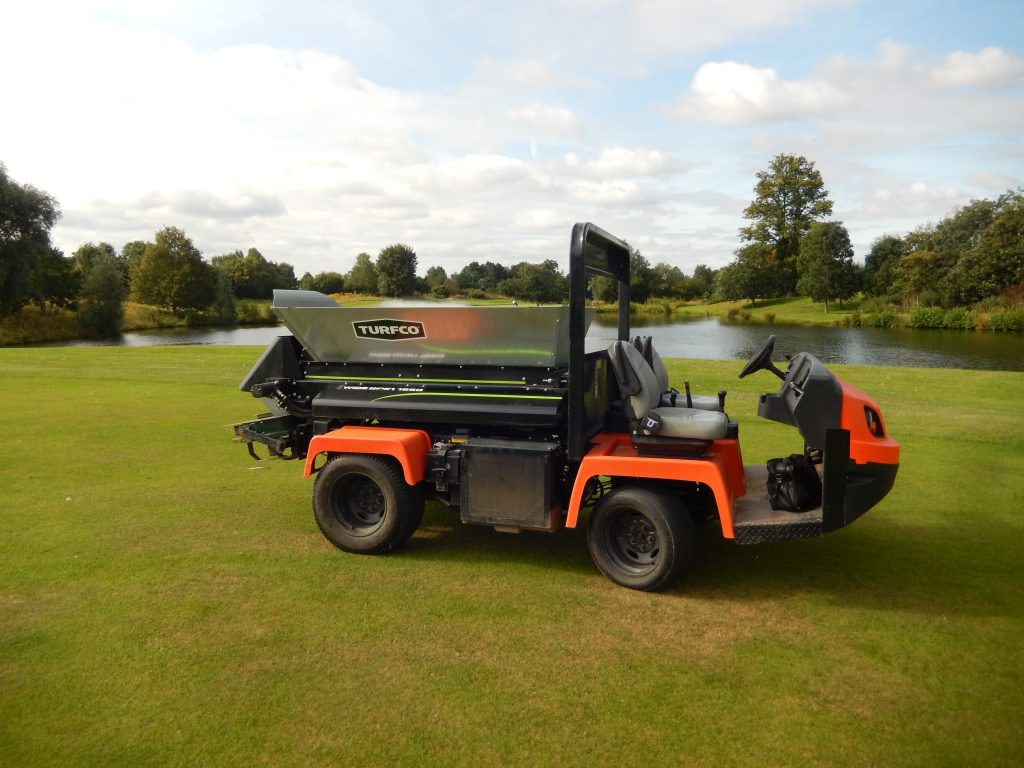
It obviously varies from venue to venue, but what is your topdressing regime and what are the particular benefits of topdressing?
We definitely embrace the ‘little and often’ theory. We can adjust the spinner speed and angle to get the exact spread we want as we move from greens to approaches to tees.
Because of the wide distribution of material, we reduce the number of passes and decrease traffic on our greens with edge-to-edge applications. Over 18 holes this also saves fuel and reduces compaction.
I think the best feature is the WideSpin’s ability to drive topdressing down into the turf by adjusting the spinner angle, minimising the need for brushing and eliminating variations in spread due to moisture content as it performs the same with both wet or dry material. The hopper, which is galvanised, has an excellent capacity and wide opening so we can refill quickly with less spillage.
Training and education are key to developing good teams, what is The Club Company’s approach to investing in raising the standard of practice and performance from greenkeeping team members and how would you describe your style of management and why do you prefer to work this way?
Right across the business the company wants to, and does, invest in its people. With regard to the greenkeeping teams, everyone is encouraged to take NVQs. Once a member of staff has been with us for three months, they qualify for industry-related training, whatever that may be. I work closely with individual course managers to assess and identify the training needs of their staff. We also encourage them to become BIGGA members as their regional training and networking events are definitely beneficial.
Defining my management style is a difficult question. I suppose you should really speak to the staff. I like to think that I’m quite laid back and empathetic, but I’m definitely not a pushover. I’ll support them 100 percent when required and deliver the odd reprimand, when necessary, but I’m sure all managers would do that. I’m really fortunate to have a great team of course managers, so if I want a specific task done, I know it will be carried out. I like to oversee, rather than interfere. What’s the point of employing good managers, if you’re going to be chasing them all the time? It’s all about trust and respect.
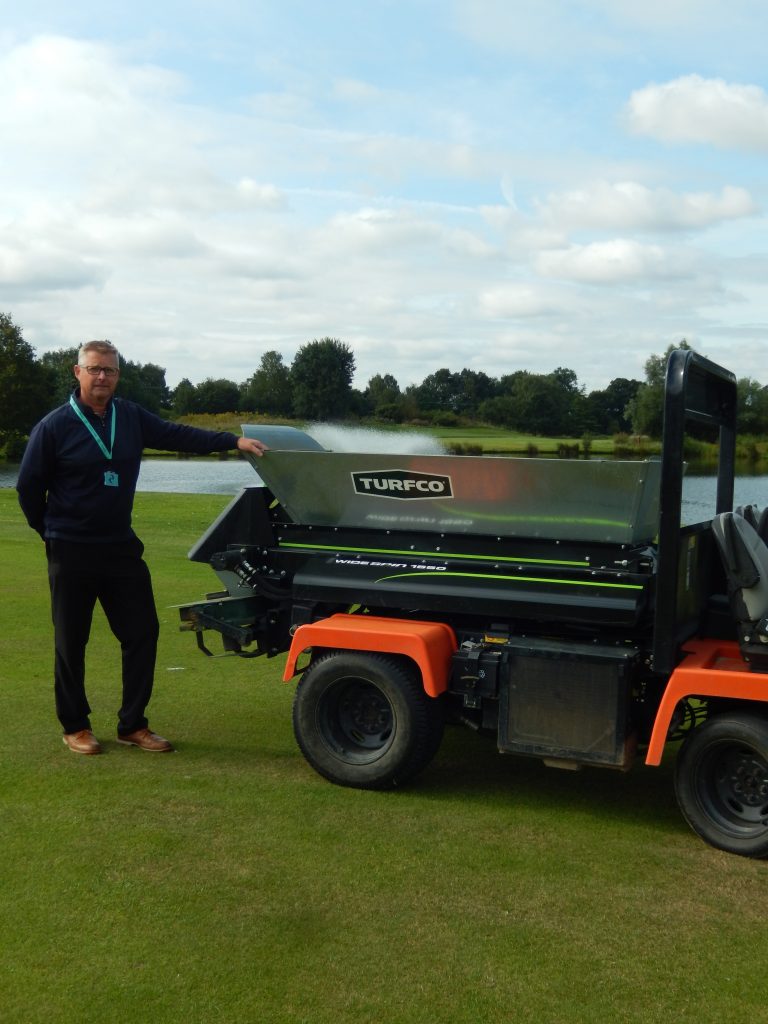
Recruitment and retention of staff is often a challenge for a business. What is the retention rate amongst your greenkeeping teams, have you found it difficult when it comes to recruiting the younger and next generation of greenkeepers and if so, what do you think needs to be done to attract people with the right attitude?
I hope we are above average with our retention of staff. We try to make our venues safe and enjoyable places to work, but we do get a certain amount of churn at entry level. It’s difficult to attract younger people; they have to like the outdoor environment and embrace the early starts, poor weather and relatively low pay to begin with. But the upside is they have a multi-seasonal place of work with abundant flora and fauna, on-the-job training, industry education, job progression and the camaraderie of a team, should they wish. One thing is certain, when you get a good one, you know it immediately!
We all have a duty to promote the sector, but I think the two industry associations, BIGGA and GMA, need to do more in schools and colleges. We need to get our message to the youngsters with a vocational ethic and promote the benefits of the industry. Senior turf managers can command excellent salaries and, with highly transferable skills, can travel the globe to ply their trade.
The Club Company encourages members to participate in a feedback survey across all areas of the business. Have you found the feedback positive, what have you learnt from the exercise and how do you think this helps you and the greenkeeping teams?
We have a club-wide ‘Feed it back’ initiative for members that goes direct to the inbox of each club’s general manager. We collate the information so that when trends emerge, we can act accordingly. If there’s a group of negative comments, then we can take action to resolve the issue and when it’s positive, the comments are fed back to the relevant teams.
It works really well; you’ll always get someone who’s had a bad round and will blame it on the course, forgetting that they are the one with the clubs in their hands, but overall, it’s been a really positive initiative right across the group.
What currently gives you the greatest satisfaction from your job, how do you feel daily when you are moving around the courses looking at what you and the teams have achieved and what do you feel are your biggest achievements and that you are most proud of to date?
I think that overall improvement in standards across all courses and their general condition, especially after the trying last 18 months. I challenge myself and the teams to make our facilities the best they can possibly be within the constraints of the budget and staffing levels.
I’m especially pleased with the camaraderie of the teams, we have some very good people; some will progress to become course managers, within the group, or outside of it, and that gives me a lot of satisfaction.
I think my biggest achievement to date is when I made the decision to leave Knebworth to go to Chesfield Downs. That was a significant life event and changed the direction of my career forever. When the group purchased the course, that set me on the path to where I am now. It was always going to a brave or stupid decision, but it’s turned out OK.
Many are now investigating battery powered mowers and other equipment, what are your views on electric mowers and what would be the benefits to The Club Group facilities?
We’re already using Jacobsen Eclipse diesel-electric hybrid greens mowers and have been for the last 10 years or so, when they were first introduced into the UK. We were early adopters, so have a lot of experience relating to the different procedures required when using electric motors; one in particular is washdown. You can’t be aggressive with a power washer on an electric motor or electrical connection.
We’re seriously looking at the new Eclipse Elite, which is completely battery powered, especially for our courses that have housing or hotels on site. At the moment we can’t cut greens in the vicinity until after 7:00, which is yet another complication with 6:00 start times!
Benefits to the group would be fuel savings; we’ve already seen this with the hybrid versions; quietness of operation and controllability. We can use the sophisticated electronic controllers to manage travel speed, mowing speed and clip rate, ensuring consistency across all greens.
It’s important to ensure people have good working conditions and you mentioned that there was a ‘care package’ for the greenkeeping teams. Please can you explain exactly what this is?
It’s not just the greenkeeping teams, it’s across all areas of the business – front of house, hotel, housekeeping, sports instructors, golf professionals and the back-office teams.
Our motto is: Caring, Ambitious, Respectful and Energising (CARE) and these are the qualities we expect in our staff and what we provide them in return. We want them to be caring and respectful of all members and visitors. We want them energised and enthusiastic to provide the best service and we encourage ambition; for them to move through the business on merit.
In return we will provide the best working conditions within our remit; be concerned for their health, welfare and safety; and monitor their skills and progress, with a view to career progression in the longer term.
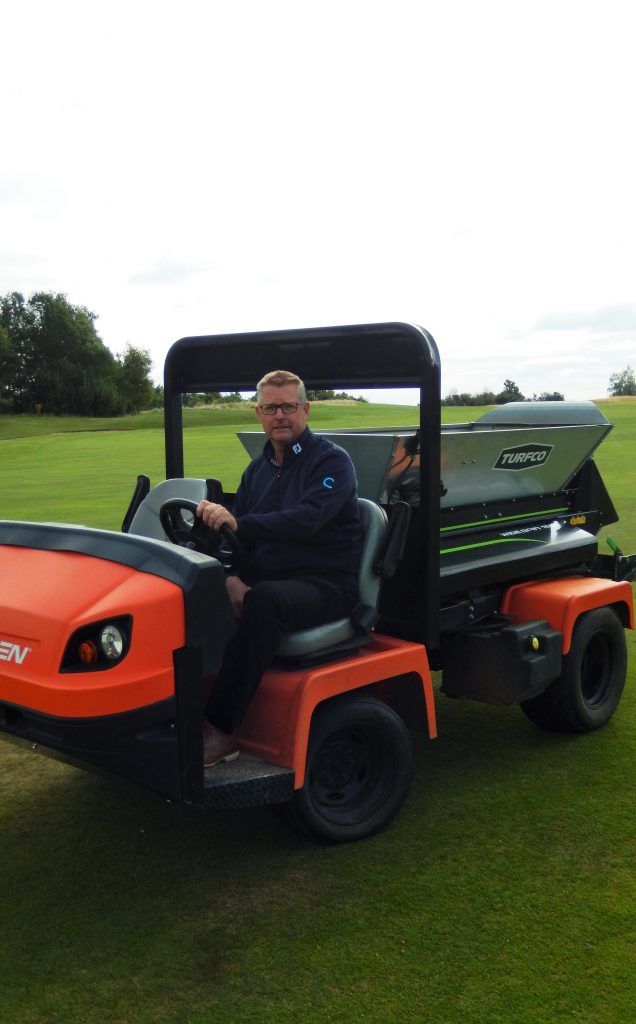
With your experience, what advice would you give to youngsters starting out and wanting to pursue a career in the profession?
If you think you would like to work in the outdoor environment, then give it a try. Have a willingness to learn, embrace all tasks enthusiastically, ask as many questions as possible because there’s never a stupid question. You’ll be mentored by more experienced team members and this will include a high proportion of hands-on training. You’ll be part of a close-knit team and embrace the camaraderie.
As you progress through your career, opportunities will arise. Many of the major suppliers to the industry have awards schemes, which can result in travel to other countries to broaden your education and experience. You’ll have the opportunity to attend major industry conventions, in the UK and overseas and the higher you get then the remuneration packages will get significantly better.
Best of all, you will learn highly transferable skills. There are golf courses in every major country across the globe, so the world is there waiting for you.
Finally, what changes do you think need to be made to benefit the industry sector and profession of the greenkeeper?
Education is getting better and it needs to. Embracing new technology is a given as we move to non-carbon power units in our equipment and we need to embrace climate change. It’s here to stay, and we may have to revisit older greenkeeping techniques, especially with regard to the lack of chemicals and pesticides.
As I stated earlier, we have to attract younger people into the profession, because it is a profession. Our industry associations must raise the profile by getting into schools and colleges and making this an attractive profession.
We can be seen as the people who just cut grass, but to be successful we have to have a wide range of skills in areas such as agronomy, chemistry, soil structure, turf disease, machinery maintenance, people management, budget control and much more. We are professionals and must be appreciated and remunerated accordingly.
Thank you, Chris, that was a hugely interesting insight into your career. I’m sure it will inspire the younger generation to appreciate that a career in this industry can be highly rewarding, in many ways.

























